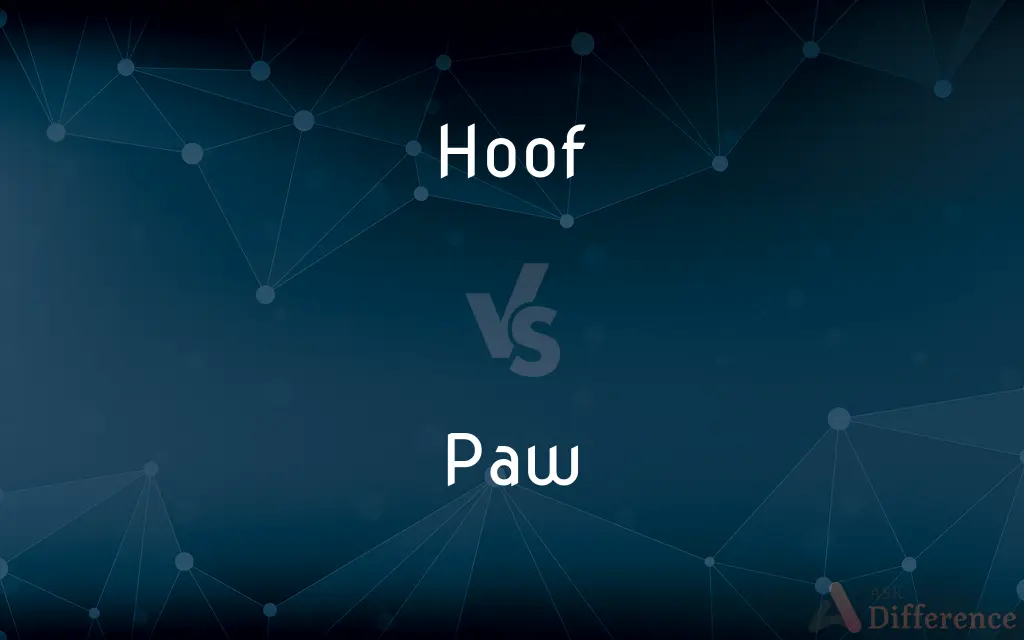Hoof vs. Paw — What's the Difference?
By Fiza Rafique & Urooj Arif — Updated on April 21, 2024
A hoof is a hard, keratinous structure encasing the toes of certain animals like horses and deer, primarily for support and locomotion on hard surfaces, while a paw is a soft, furry, foot of animals like cats and dogs, equipped with claws for grasping.

Difference Between Hoof and Paw
Table of Contents
ADVERTISEMENT
Key Differences
A hoof is composed of tough keratin, similar to human nails, and covers the end of the toes in ungulate animals such as horses, cows, and goats. This structure helps support the considerable weight of these animals and provides durability for movement over various terrains. On the other hand, a paw includes a soft pad and claws, found in animals like dogs and cats, designed to cushion the impact of movement and allow for agile maneuvers, as well as aiding in hunting or self-defense.
Hooves are singular structures that encompass the toe or toes of an animal, usually evolved to aid in fast and efficient running and minimal resistance against the ground. Paws, however, have multiple components including pads and digits that can move independently, aiding in gripping surfaces, and are typically covered with fur for additional protection against environmental elements.
The maintenance of hooves involves regular trimming and sometimes shoeing by a farrier to prevent overgrowth and wear that can lead to discomfort or injury. In contrast, paws generally require less specialized care, though they still need regular checks for injuries, debris, and excessive claw growth which can affect an animal’s comfort and health.
In terms of adaptation, hooves have evolved to enhance an animal's ability to travel long distances or achieve high speeds on open terrains such as plains. Conversely, paws have adapted to a variety of habitats, from urban environments to dense forests, where precision, flexibility, and protection from rough surfaces are necessary.
Hoofed animals (ungulates) are predominantly herbivores, using their specialized feet for escape from predators through speed and endurance. Animals with paws include both carnivores and omnivores, using their versatile feet for a range of activities from hunting to climbing and digging.
ADVERTISEMENT
Comparison Chart
Composition
Hard keratin
Soft pads, fur, and claws
Function
Supports weight, facilitates fast movement
Cushions impacts, provides grip and traction
Care
Requires trimming and shoeing
Needs regular checking and claw trimming
Adaptation
Suited for open, hard terrains
Versatile, suited for varied environments
Typical Animals
Horses, deer, cows
Cats, dogs, bears
Compare with Definitions
Hoof
Found in ungulates.
Cows and goats both have hooves that help them traverse rough terrain.
Paw
Less specialized maintenance than hooves.
While paws require care, they generally don’t need professional maintenance.
Hoof
Hard covering of the toes of certain animals.
The horse’s hoof needs regular shoeing to prevent damage.
Paw
Covered in fur for protection.
The fur around the dog’s paws helps protect against cold weather.
Hoof
Adapted for speed and endurance.
The antelope’s hooves are perfectly adapted for quick, long-distance running across the savannah.
Paw
Found in a wide range of animals including carnivores and omnivores.
Raccoons have very dexterous paws used for handling food and other objects.
Hoof
Made of keratin, similar to human nails.
Just like our nails, a hoof grows continuously and needs to be trimmed.
Paw
Foot of an animal that has claws and soft pads.
The cat’s paw is highly sensitive to touch and temperature.
Hoof
Requires care from a farrier.
The farrier visits regularly to maintain the health of the animals' hooves.
Paw
Used for gripping and walking.
A bear’s paws are versatile, aiding in climbing trees and manipulating food.
Hoof
A hoof ( or ), plural hooves ( or ) or hoofs , is the tip of a toe of an ungulate mammal, strengthened by a thick and horny keratin covering.Artiodactyls are even-toed ungulates, meaning that these species have an even number of digits on each foot. Ruminants, with two main digits, are the largest group.
Paw
A paw is the soft foot-like part of a mammal, generally a quadruped, that has claws.
Hoof
The horny sheath covering the toes or lower part of the foot of a mammal of the orders Perissodactyla and Artiodactyla, such as a horse, ox, or deer.
Paw
The foot of an animal, especially a quadruped, that has claws or nails.
Hoof
The foot of such an animal, especially a horse.
Paw
(Informal) A human hand, especially a large clumsy one
"Lennie dabbled his big paw in the water" (John Steinbeck).
Hoof
(Slang)The human foot.
Paw
To feel or strike with the paw or paws.
Hoof
To trample with the hooves.
Paw
To strike or scrape with a beating motion
The bull pawed the ground before charging.
Hoof
To dance, especially as a professional.
Paw
To touch or handle clumsily or roughly.
Hoof
To go on foot; walk.
Paw
To feel or touch (another) in an annoying or unwanted way.
Hoof
The tip of a toe of an ungulate such as a horse, ox or deer, strengthened by a thick keratin covering.
Paw
To scrape the ground with the forefeet
The horse pawed restlessly.
Hoof
(slang) The human foot.
Get your hooves off me!
Paw
To handle someone or something clumsily, rudely, or with too much familiarity
Don't paw at everything you see.
Hoof
An ungula.
Paw
The soft foot of a mammal or other animal, generally a quadruped, that has claws or nails; comparable to a human hand or foot.
Hoof
To trample with hooves.
Paw
(humorous) A hand.
Get your grubby paws off my things!
Hoof
(colloquial) To walk.
Paw
Father; pa.
Hoof
(informal) To dance, especially as a professional.
Paw
(of an animal) To go through something (such as a garbage can) with paws.
Hoof
To kick, especially to kick a football a long way downfield with little accuracy.
Paw
(of an animal) To gently push on something with a paw.
Hoof
The horny substance or case that covers or terminates the feet of certain animals, as horses, oxen, etc.
On burnished hooves his war horse trode.
Paw
(of an animal) To draw the forefoot along the ground; to beat or scrape with the forefoot.
Hoof
A hoofed animal; a beast.
Our cattle also shall go with us; there shall not a hoof be left behind.
Paw
(by extension) To clumsily dig through something.
Hoof
See Ungula.
Paw
To flatter.
Hoof
To walk as cattle.
Paw
The foot of a quadruped having claws, as the lion, dog, cat, etc.
Hoof
To be on a tramp; to foot.
Paw
The hand.
Hoof
The foot of an ungulate mammal
Paw
To draw the forefoot along the ground; to beat or scrape with the forefoot.
Hoof
The horny covering of the end of the foot in hoofed mammals
Paw
To pass the paw over; to stroke or handle with the paws; hence, to handle fondly or rudely.
Hoof
Walk;
Let's hoof it to the disco
Paw
To scrape or beat with the forefoot.
His hot courser pawed the Hungarian plane.
Hoof
Dance in a professional capacity
Paw
A clawed foot of an animal especially a quadruped
Paw
The (prehensile) extremity of the superior limb;
He had the hands of a surgeon
He extended his mitt
Paw
Scrape with the paws;
The bear pawed the door
Paw
Touch clumsily;
The man tried to paw her
Common Curiosities
Are there any animals with both hooves and paws?
No, animals typically have either hooves or paws based on their evolutionary needs and habitat adaptations.
Can all animals with hooves run fast?
Most hoofed animals are adapted for running, which helps them escape predators; however, not all hoofed species are built for high-speed running.
What is the main function of a hoof?
The main function of a hoof is to support the weight of the animal and provide a durable, stable platform for movement on hard surfaces.
How do claws function in animals with paws?
Claws help in gripping surfaces, aid in hunting, and serve as a means of self-defense.
What are the environmental adaptations seen in hooves and paws?
Hooves are adapted to open, hard terrains for efficient running, while paws are more versatile, allowing animals to navigate through various types of environments including urban areas, forests, and rocky terrains.
What role do hooves and paws play in an animal's survival?
Both play critical roles—hooves in facilitating efficient movement to escape predators and travel long distances, and paws in providing agility, grip, and the ability to manipulate the environment for food and shelter.
How does the care for hooves and paws differ?
Hoof care is specialized and often requires professional attention for trimming and shoeing, whereas paw care mainly involves regular checking and occasional claw trimming.
What types of animals have hooves, and what types have paws?
Ungulates like horses, cows, and deer have hooves, while mammals like dogs, cats, and bears have paws.
Can the condition of hooves or paws affect an animal's health?
Yes, the health of both hooves and paws is crucial for an animal's overall mobility and well-being. Poorly maintained hooves or injured paws can lead to pain, decreased mobility, and other health issues.
Why do paws have pads?
Pads on paws provide cushioning against impacts and protect sensitive inner tissues from damage while walking or running.
Share Your Discovery

Previous Comparison
Convalescent vs. Invalid
Next Comparison
Belt vs. SashAuthor Spotlight
Written by
Fiza RafiqueFiza Rafique is a skilled content writer at AskDifference.com, where she meticulously refines and enhances written pieces. Drawing from her vast editorial expertise, Fiza ensures clarity, accuracy, and precision in every article. Passionate about language, she continually seeks to elevate the quality of content for readers worldwide.
Co-written by
Urooj ArifUrooj is a skilled content writer at Ask Difference, known for her exceptional ability to simplify complex topics into engaging and informative content. With a passion for research and a flair for clear, concise writing, she consistently delivers articles that resonate with our diverse audience.
















































